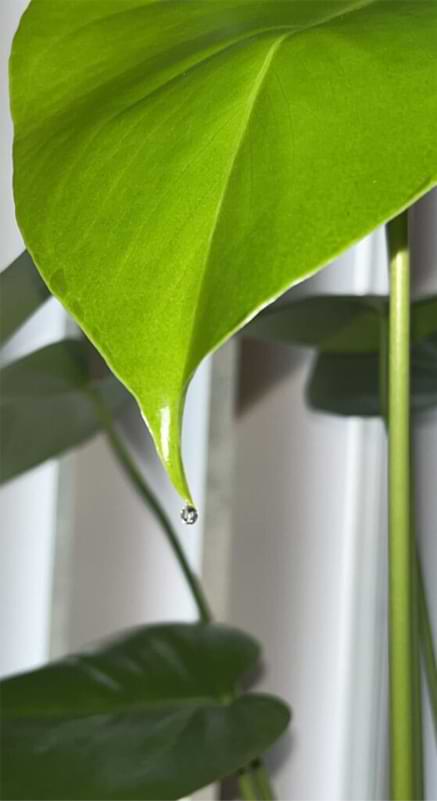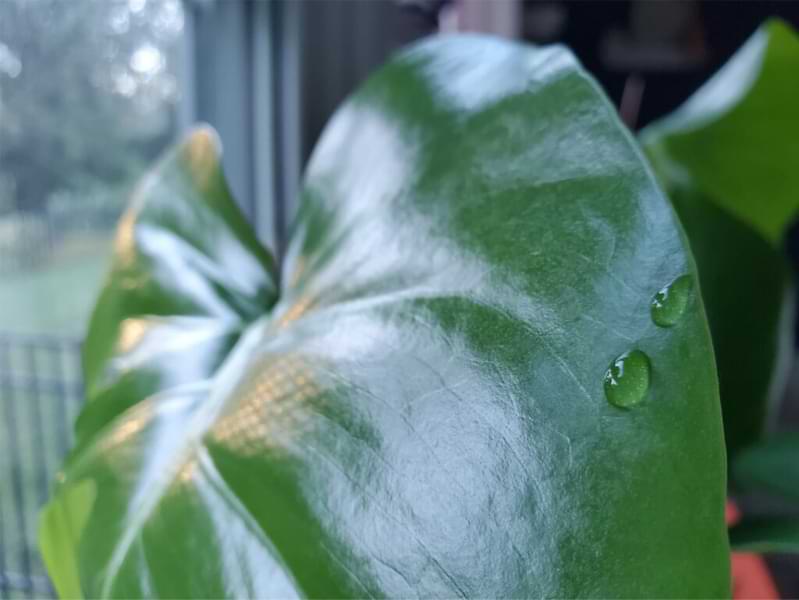Have you ever noticed your Monstera dripping water or “sweating” leaves? And wondered why in the world it’s doing that? It turns out there’s a perfectly good explanation for this phenomenon and it is the plant’s natural adaptations for survival. In this article, we’ll explore why Monsteras drip water and how you can prevent it from happening if you don’t want your plant to be quite so messy.
Table of Contents
Causes of Monstera Leaves Dripping Water or ‘Sweating’
One of the most common reasons for Monstera leaves dripping water or ‘sweating’ is because of high humidity or too much water in the pot. It’s simply a way for your plant to get rid of the extra moisture that it doesn’t need. Dripping water from plant leaves is called “guttation,” and, for the most part, it is completely harmless. Read on for more information about it and a list of potential causes behind it.
Understanding The Difference Between Guttation and Dew
Guttation is the process by which plants release water from their leaves. This water is typically in the form of drops, and it can be clear or colored. Dew, on the other hand, is water that condenses on plant leaves. Unlike guttation, dew does not come from within the plant; rather, it forms when humid air comes into contact with cool surfaces (like leaves).
Is Dripping Water Bad for Monstera?
If your Monstera is dripping water, it’s not necessarily a bad thing. In fact, it could be a good sign that your plant is healthy and happy!
The water that drips from your monstera’s leaves is just water mixed with minerals. Together, it’s called xylem sap, and it’s completely harmless to both your plant and your home. Although larger plants may cause a bit of a mess, it’s really nothing to be too concerned about as long as the cause of the guttation isn’t ignored for too long.
If you’re not sure why your Monstera is dripping water, don’t worry! Just give it a little time and see if the problem corrects itself. In most cases, there’s no need to worry about a few drops of water here and there. Check out the causes below to see if one of these problems may cause your plant to drip water from its leaves.
Causes of Guttation in Monstera
There are a few reasons your Monstera might drip water, or “sweating.” Most of the time, it’s nothing to worry about and is simply the plant’s way of regulating its temperature or getting rid of excess water. However, there are a few potential causes for guttation that you should know.
Excessive Watering
If you’re noticing water droplets or “sweat” on the leaves of your monstera, it’s most likely because of excessive watering. Over-watering is a common problem with indoor plants, and can lead to a variety of issues including leaf drop, yellowing leaves, and root rot.
To avoid over-watering, be sure to check the soil before watering and only water when the top inch or two is dry. Allow the plant to drain thoroughly after watering and never leave it sitting in water. If you’re unsure how often to water, err on the side of caution and water less frequently rather than more. Your plant will usually let you know if it isn’t being watered enough.
Over Fertilizing
For houseplants, more fertilizer is not always better. Over fertilizing is a common issue that can lead to several problems for your plants, including leaf burn, root rot, and even death. One sign of over fertilizing is guttation, and although guttation itself isn’t harmful to your plant, if it’s happening because your plant has been over-fertilized, it may be an issue.
If you think your plant might be over fertilized, the first step is to flush the potting mix with water to leach out some of the excess fertilizer. If the plant is still showing signs of distress, you may need to repot it into a fresh potting mix.
Once you have corrected the problem, be sure to only fertilize your plants as needed and according to the manufacturer’s instructions.
Monstera Needs Re Potting
Another cause of guttation in your Monstera is when the plant needs to be repotted. It is likely due for a re-potting if you notice it is sweating water droplets.
If your Monstera is dripping water, it could mean that the roots are too crowded and need more room to grow. Re-potting will also help to aerate the roots, which will encourage new growth. It could also mean that the soil has compacted too much for your plant’s roots to breathe properly. If the soil around your plant is too dense, it will not allow adequate airflow and the plant will start to sweat in order to get rid of excess moisture.
It is best to re-pot your Monstera in the spring or summer when the plant is actively growing. Choose a pot that is only slightly larger than the current pot, as Monsteras prefer to be potbound. Be sure to use a well-draining potting mix and water thoroughly after replanting.
Environmental Stresses
Sweating leaves is a perfectly normal response to environmental stresses, and as long as the cause is taken care of before the plant is actually damaged, it’s nothing to worry about. Environmental stresses can range from temperatures to humidity levels, sunlight and more. So go through the prevention guide below to make sure you’re giving your plant the best chance to thrive in your home without sweating.
If your plant is not getting enough light, it will start to sweat in order to compensate for the lack of light, and if the temperature around your plant is too hot, the plant will sweat in order to cool down. In both cases, you’ll want to move your plant to a spot that provides some additional light and ventilation if possible.
Monsteras don’t like drafts, so if it’s in a spot where there’s a lot of air movement, it may sweat as a way to cool down. Move your plant to a more sheltered spot if this is the case.

How to Prevent Monstera Leaves Sweating
To prevent your Monstera leaves from sweating, here are a few tips:
Reduce Watering Schedule
Water your Monstera when the topsoil feels dry to the touch. Allow the water to run through the drainage holes at the bottom of the pot, and empty any excess water from the saucer. Water less frequently in winter, when growth slows down.
When you first get your Monstera, it’s best to wait until the soil has dried out completely before watering it for the first time. This will help to prevent root rot. After that, water your plant whenever the topsoil feels dry to the touch. To be extra careful with your watering schedule, using a moisture meter will take all the guesswork out of when to water your plant.
Fertilize to a Schedule
Fertilizing your Monstera on a schedule is important to keeping your plant healthy. While over-fertilizing can be harmful, under-fertilizing will result in a weaker plant that is more susceptible to pests and disease. A good rule of thumb is to fertilize every other week during the growing season and once a month during the winter.
When selecting a fertilizer for your Monstera, be sure to choose one that is high in nitrogen. This nutrient is essential for leaf growth, so a fertilizer with a higher nitrogen content will promote healthier leaves.
A much easier way to ensure your plant is getting all the nutrients it needs is to feed it with a Monstera Plant Food instead of fertilizing every 2-4 weeks. I prefer this option because you are giving the plant a smaller amount of nutrients more frequently, giving your plant a better opportunity to use those nutrients. With this method, you don’t have to worry about fertilizer burn at all, and that’s a huge win in my book.
Repot Up to Every 2 Years
Most Monstera plants will need to be repotted every 2 years. This is because they are such fast growers. If you notice that your plant is looking pot bound (roots coming out of the drainage holes), then it’s time to re-pot.
To re-pot your Monstera, start by selecting a new pot that is only 1-2 inches larger in diameter than the current pot. Be sure to select a pot with really good drainage.
Next, prepare some fresh potting mix. You can either use a pre-made monstera plant potting mix or make your own by mixing equal parts perlite, vermiculite, and peat moss.
Gently loosen the root ball and carefully place it into the new pot. Once your plant is in its new home, fill in around the root ball with fresh potting mix. Water well and allow the top inch of soil to dry out before watering again.
Ensure Temperatures Remain Constant
If your Monstera’s leaves are dripping water, it could be because the temperature in its environment is too hot or too cold. If the temperature changes suddenly, the plant can also sweat to cool itself down. To ensure that your Monstera doesn’t start sweating, keep the temperature around it constant. This plant likes tropical temperatures between 60 and 80 degrees.
Reduce Humidity and Increase Air Circulation
If your monstera is sweating water, it’s likely because the humidity in your home is too high. To reduce humidity, you can:
- Turn on a dehumidifier
- Open windows to increase air circulation
To increase air circulation, you can:
- Use a fan
- Move your plant to a spot near an open window only on mild days where the temperature is above 65 and below 80 degrees.
Improve Soil Drainage and Nutrients by Replacing
This goes along with your plant getting too much water and trying to find a way to get rid of the extra. If you improve your plant’s soil drainage, it will usually always stop your plant from dripping water.
You should also ensure that your plant’s soil has all the nutrients it needs to help your plant thrive, and this will also help prevent sweating.
Improve Light Conditions
Improving the light conditions for your monstera will help prevent sweating. If your plant is getting too much sun, you can try moving it to a shadier spot. If it’s not getting enough sun, you can try moving it to a brighter spot or use grow lights near your plant to give it the extra light it needs.

FAQ Sweating Monstera Leaves
Why is my monstera sweating at night?
At night, when the temperature drops, your Monstera’s leaves will sweat. This is called transpiration, and it’s how plants regulate their temperature and moisture levels.
When the humidity is low, transpiration happens more quickly to keep the plant’s cells hydrated. In high humidity, transpiration slows down because there is already plenty of moisture in the air for the plant to absorb. So if you see your Monstera sweating at night, it’s likely due to low humidity levels in your home.
Monstera Dripping Water or Sweating Final Thoughts
There are many reasons your Monstera might drip water or sweat through the leaves. If you think your plant is suffering from any of the issues mentioned above, take action sooner rather than later. Although it’s not an issue that will kill your plant quickly, you should still try to fix the reason behind your plant sweating to make sure your plant is thriving in its environment.
If you’re still not sure what’s causing the problem, consider taking a sample of your plant to a local nursery or greenhouse for diagnosis. Once you know what’s wrong, you can take steps to correct the issue and help your Monstera thrive.
More Monstera Resources
Learn more about caring for these amazing plants!





